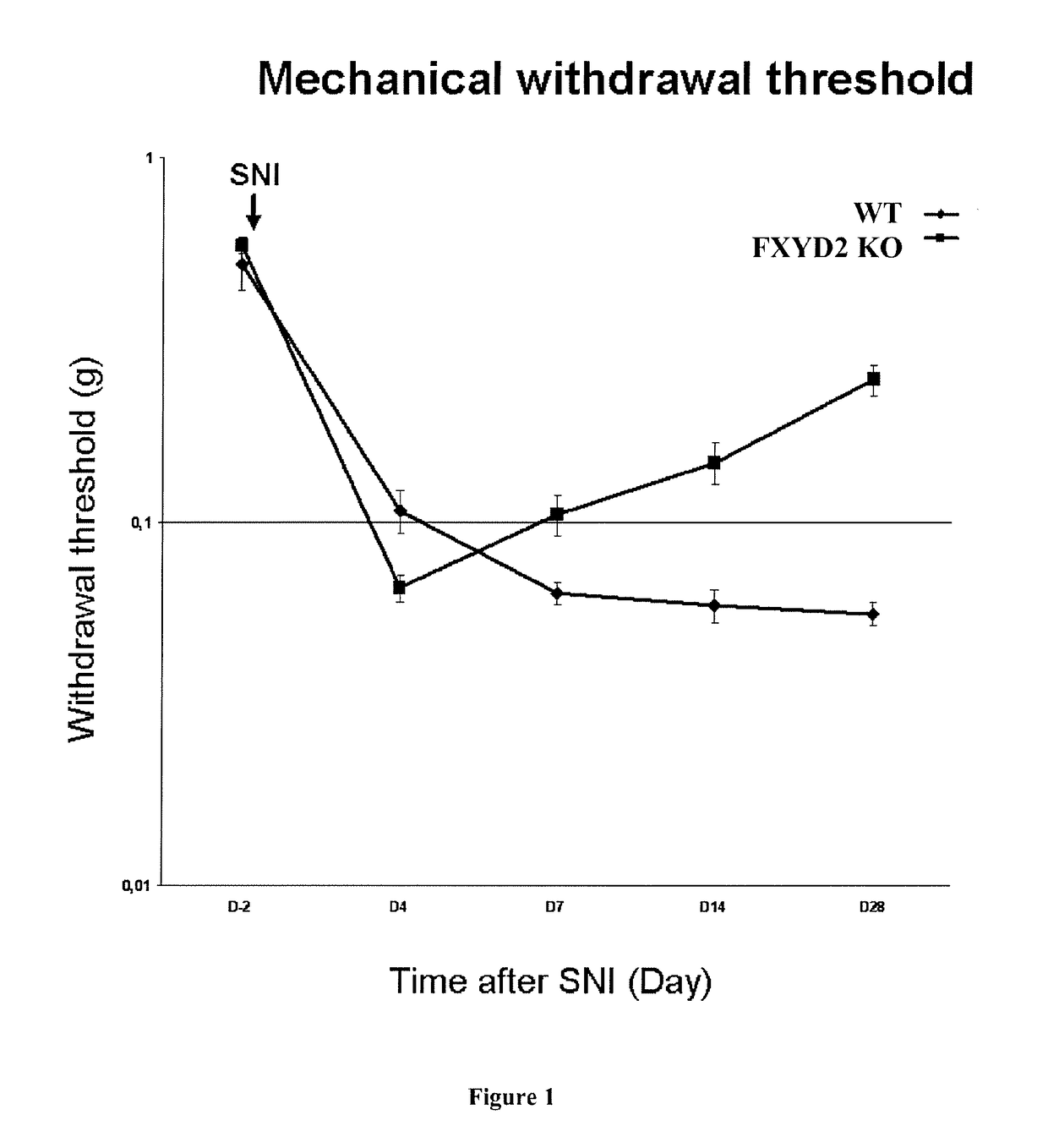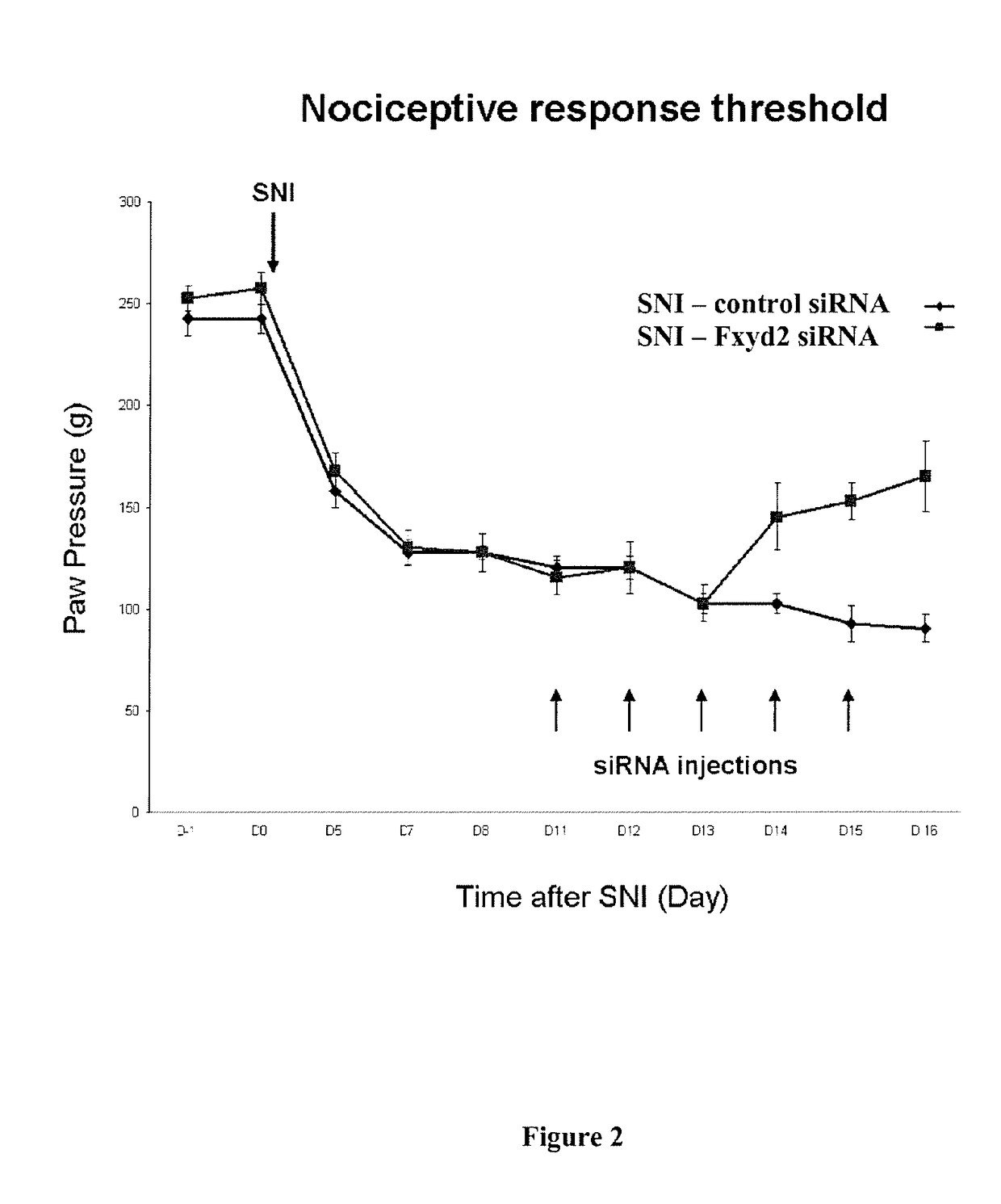Methods and Compositions for Treating Neuropathic Pain
a neuropathic pain and composition technology, applied in the field of neurology, can solve the problems of ineffectiveness of agents that treat one kind of pain, inability to reduce or alleviate neuropathic pain by non-steroidal drugs, and inability to treat neuropathic pain at all in some patients
- Summary
- Abstract
- Description
- Claims
- Application Information
AI Technical Summary
Benefits of technology
Problems solved by technology
Method used
Image
Examples
example 1
[0062]Material & Methods
[0063]Animals and Surgery:
[0064]All experiments were approved by the Direction Départementale des Services Vétérinaires de l'Hérault (Certificate of Animal Experimentation n° 34-376,17 February 2009) and the guidelines of the International Association for the Study of Pain (IASP).
[0065]Eight-to-ten week-old C57BL / 6 male mice (Charles River, France) or Fxyd2 null mice (Jones et al, 2005) were housed with a 12 / 12 dark / light cycle and ad libitum access to water and food (n=6 in each group). Male Sprague-Dawley rats (Janvier), weighing 200 to 250 g (4 to 5 weeks of age) at the beginning of the experiments, were used.
[0066]Animals were deeply anesthetized with Ketamine-Xylasine (respectively 100 mg / kg and 10 mg / kg), and unilateral spared nerve injury (SNI) surgery was performed (Decosterd and Woolf, 2000). Briefly, the left hindlimb was immobilized in a lateral position and slightly elevated. Skin incision was made at mid-thigh level using the femur as a landmark,...
example 2
[0079]Materials and Methods
[0080]Real-Time qPCR
[0081]1 μg of total RNA from human DRGs (Clontech, Lot number 1105216A) or from human fibroblasts (provided by Dr. C. Angebault-Prouteau) were reverse-transcribed with 100 U of Superscript II reverse transcriptase (Invitrogen) and 5 μM hexamer random primers (Boehringer Mannheim), 0.5 mM of each dNTPs (Pharmacia), 10 mM of dithiothreitol and 20 U of recombinant RNase inhibitor (Promega) for 1 hour at 37° C. and then stored at −80° C. until use. Real time PCR was carried out as described previously (Elzière et al., 2014) using SYBR Green I dye detection on the LightCycler system (Roche Molecular Biochemichals). PCR reactions were performed in 96 well plates in a 10 μl volume containing 3 μl of RT product (final dilution 1 / 30), 0.5 μM of forward and reverse primers, and 2 μl of QuantiTect SYBR Green PCR Master Mix (Roche Diagnosis). Amplified products were sequenced at least once (Beckman Coulter Genomics, UK). The relative amounts of spe...
PUM
| Property | Measurement | Unit |
|---|---|---|
| volume | aaaaa | aaaaa |
| volume | aaaaa | aaaaa |
| volume | aaaaa | aaaaa |
Abstract
Description
Claims
Application Information
 Login to View More
Login to View More - R&D
- Intellectual Property
- Life Sciences
- Materials
- Tech Scout
- Unparalleled Data Quality
- Higher Quality Content
- 60% Fewer Hallucinations
Browse by: Latest US Patents, China's latest patents, Technical Efficacy Thesaurus, Application Domain, Technology Topic, Popular Technical Reports.
© 2025 PatSnap. All rights reserved.Legal|Privacy policy|Modern Slavery Act Transparency Statement|Sitemap|About US| Contact US: help@patsnap.com



